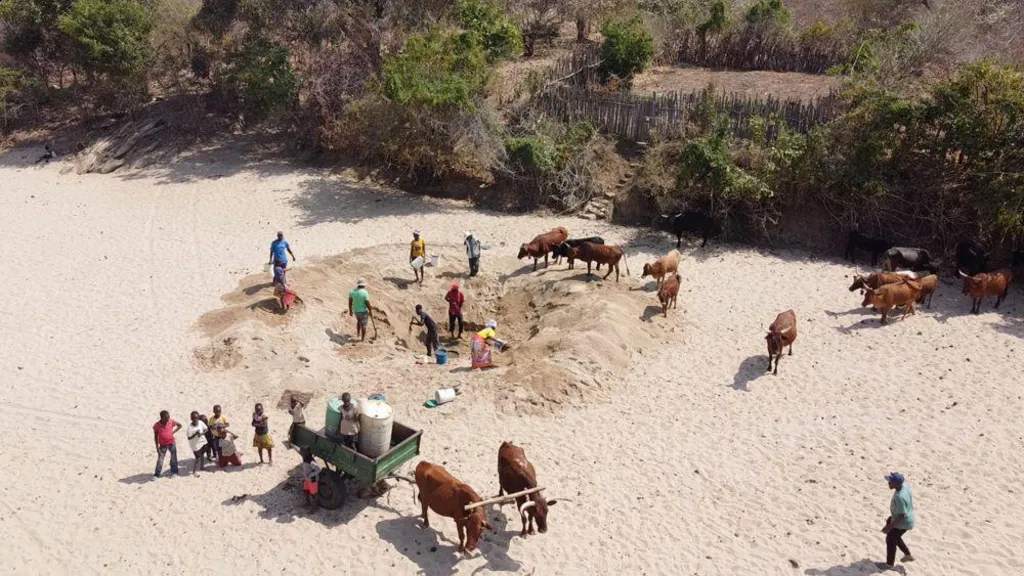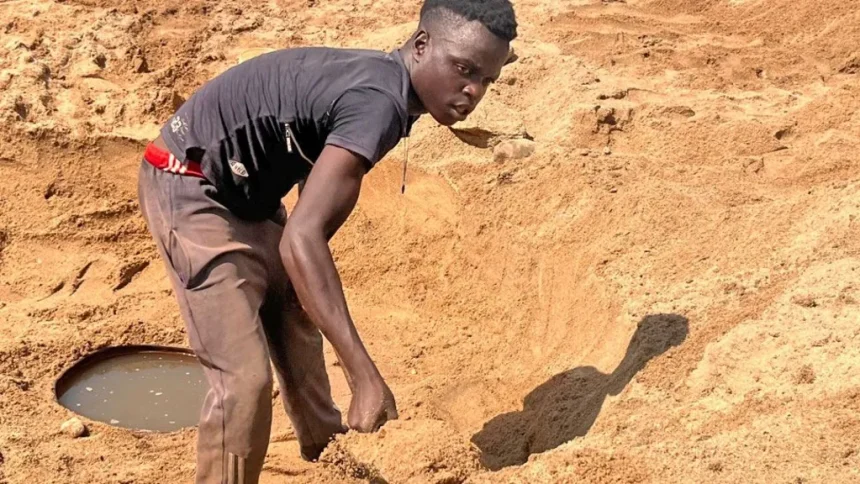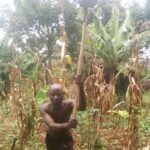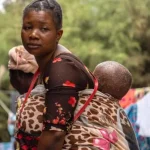One of the worst droughts in living memory is sweeping across southern Africa, leaving close to 70 million people without enough food and water.
In Mudzi district in northern Zimbabwe, a community and their livestock are gathered on a bone-dry riverbed. The Vombozi normally flows throughout the year but right now, it is just beige sand as far as the eye can see.
Armed with shovels and buckets, the men are digging into the river floor, desperately trying to extract the last drops of water from it.
Rivers and dams have dried up in other parts of the district and as a result more and more people are descending on this specific riverbed in Kurima village, putting pressure on the water source.
Along the riverbed are several holes, large enough to fit a single bucket.
Children are bathing, women are doing laundry and giving their bellowing cattle drinks of water.
Gracious Phiri, a mother of five, stands among these women. The 43-year-old tells the BBC she now has to walk further than usual, spending three hours every day travelling to fetch water.
Ms Phiri lowers her bucket into the half-metre (19in) wide hole and draws brown-coloured water. She worries about her family getting sick.
“As you can see, the cattle are drinking from the same pit as us. Their urine is right there… it is not very healthy,” she says.
“I have never seen anything like this.”
Food is also in short supply in Zimbabwe where 7.7 million people face hunger. In Mudzi the number of families who have access to a sufficient amount of affordable, nutritious food has dropped by more than half compared to previous years, the local health authority says.
Children have been particularly impacted – since June hospital admissions for youngsters with moderate to severe malnutrition have doubled.
A village feeding programme is trying to tackle the problem. Once a week women in the community gather, bringing whatever produce they have in order to contribute to a porridge for under fives.
Ground baobab fruit, peanut butter, milk andleafy green vegetables are stirred into the porridge to add extra nutrients.
But the list of ingredients shrinks every week – cow-peas and beans recently became unavailable because of the poor harvests.
The government, with the support of partners like the UN children’s agency, Unicef, devised the village feeding scheme and it used to run at least three times a week.
“But because of the El Niño drought we are now only giving it once a week,” explains Kudzai Madamombe, Mudzi district’s medical officer.
“Because the rains didn’t come, we suffered a 100% loss in terms of all the crop,” he adds, saying the programme might be forced to stop altogether in the next month as food stocks dwindle.
Clinics providing Zimbabweans in Mudzi with vital healthcare have also been affected – boreholes that supply a quarter of clinics in the district with water have run dry, Mr Madamombe says.
And the major dam in the district has only a month’s supply of water left.
As a result vegetable irrigation schemes, including one which supported 200 local farmers, have been suspended.
The misery is everywhere. Tambudzai Mahachi, 36, says she planted acres of maize, cow-peas and peanuts on her plot.
For all her hard work, she got nothing at all, not even a plate of food. Even her hardy baobab tree produced hardly any fruit.

In a good year Ms Mahachi says she would normally supply markets in the capital, Harare, but she is now among the millions of Zimbabweans relying on handouts.
While the village feeding scheme provides food one day of the week, her children need to eat every day.
Seated in a thatched hut, she boils wheat so she can provide her two children with breakfast. The wheat was supplied by a charitable neighbour.
“We have gone from eating what we want and when we want to limiting meals,” Ms Mahachi says.
“The older girl understands that we sometimes can only have porridge. But at times I can see that my youngest is hungry.”
The rains failed in most of southern Africa this year, on a continent where most of the agriculture relies on rainfall, rather than irrigation, for water.
The drought has prompted about a third of the countries in southern African to declare a state of disaster. A massive 68 million people across the region need food aid.

The Southern African Development Community (Sadc) – a grouping of countries in the region – appealed for $5.5bn (£4bn) in aid to combat the effects of droughtin May. So far, only a tiny fraction has been received.
“If you go anywhere in southern Africa, family granaries are empty, and maize, which is the region’s most consumed in terms of carbohydrates, is now priced out of many people’s hands,” Tomson Phiri, southern African spokesperson for the UN World Food Programme (WFP), tells the BBC.
“The situation is only going to get worse.”
The WFP has only received one fifth of the $400m its needs for emergency assistance, he says, adding that southern Africa is experiencing its largest deficit in maize in 15 years.
And the hunger and water crisis is yet to peak – October, the hottest and driest month of the year, is still a long way off.
If rain falls in November or December, which is when the rainy season typically starts, farmers will have to wait until March to harvest maize.
It is something Ms Mahachi is acutely aware of as she cracks open some wild fruit to stave off her hunger pangs, unsure about what lies ahead in the coming months for her young family.













